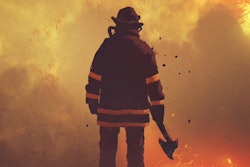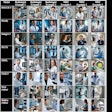
The endurance of the human body, mind, and spirit is amazing. It's what allows us to continue to perform our roles and responsibilities, to a point -- but we all have a breaking point.
 Stefanie Manack.
Stefanie Manack.The physical and mental endurance required of frontline healthcare workers is enormous. Imaging staff play a vital role in the healthcare continuum, responsible for producing specialized images -- a crucial part of determining a patient's diagnosis.
Yet, radiologic technologists, the third largest group of healthcare professionals,¹ are often overlooked as frontline healthcare workers. There is a lack of recognition of the mental and physical stressors the imaging team faces daily.
A technologist's job is physically demanding. Wearing heavy lead aprons for extended periods; pushing heavy equipment; lifting, moving, and transporting patients; and performing repetitive movements can all cause physical injuries.
While we usually think about the physical aspects of the job because those are apparent, we don't typically think or talk about the emotional toll the job can take on individuals. The situations encountered by technologists can leave an indelible impression, and not always a good one. The emotional burden they carry after imaging a severely injured trauma patient or being the first to see scans come up showing disease or a massive tumor are heavy ones.
 Judy Zakutny.
Judy Zakutny.Furthermore, staff shortages and fewer people entering the field of radiography have put undue strain on existing staff and dramatically increased their workload. Stress has led to early retirement or leaving the field entirely for many experienced individuals in the imaging profession. These different types of stressors can lead to compassion fatigue, moral injury, burnout, and even post-traumatic stress disorder (PTSD).
Compassion fatigue is defined as the physical and mental exhaustion and emotional withdrawal experienced by those who care for sick or traumatized people over an extended period of time.² It's the reduced capacity for compassion that can happen with the continual emotional weight of helping others that are suffering.
People experience mental and emotional exhaustion, mood swings, and a loss of morale and feelings of self-worth. The reduced feelings of purpose or meaning in their work can lead to isolation and a sense of helplessness. The resulting emotional disconnection plays out at work, in their personal life, or both.
Burnout is caused by a perceived imbalance in one's work/life balance, coupled with a belief that the disruption is caused by institutional factors out of their control. Chronic work stressors like increased job demands, lack of acknowledgment, and working in unfamiliar situations can all lead to burnout.
Increasingly, healthcare workers are experiencing symptoms of exhaustion, negative feelings toward their job, and feelings of being devalued by their organization. The anger and negative emotions often bleed over into their personal life and relationships.
Struggling with ensuring that the patient's needs come first is at the root of moral injury. Moral injury describes the challenge of simultaneously knowing what care patients need but being unable to provide it due to constraints that are beyond one's control.³
These constraints can come in the form of inadequate supplies, equipment, or staffing; being forced to work in an unfamiliar clinical setting; or by managing expectations of one stakeholder over another.
Moral injury is another cause of the exodus across healthcare for staff and leaders, but it is much deeper and more problematic over the long term than burnout. The signs and symptoms of moral injury run deep -- shame, guilt, and feelings of helplessness and self-blame are common. The withdrawal and self-isolation that result can lead to a pronounced decrease in social interaction in both the professional and personal spheres.
PTSD refers to an experience that leaves an indelible mark so profound that a reliving of the original event can be triggered by a sound, a smell, or an event. Once triggered, the individual is transported back to the original event, complete with the full range of emotions and reactions they experienced at the time such as fear, terror, anxiety, and "fight-or-flight" responses. Panic attacks and flashbacks are also common.
While PTSD is often associated with combat veterans, healthcare has recently been included as an at-risk profession. Healthcare workers, including imaging personnel, are often witness to a wide range of illness, trauma, hardship, pain, and suffering. Avoidance of triggers is the most common coping mechanism, adding PTSD to the list of contributing factors leading to the exodus of healthcare workers.
Even though we may not be experts in recognizing these mental health issues, we can recognize signs when someone is struggling and needs support. Helping your team, your co-workers -- and yourself -- recognize the warning signs and find the support needed is imperative to addressing issues and promoting emotional wellbeing.
Understanding what resources are available from your employer to address mental health issues is the first step in finding help. In addition to understanding what your employer offers, there are numerous online and virtual resources specifically for healthcare professionals designed to address challenges and improve emotional well-being.
It's critically important we recognize that these mental health issues are adversely affecting the imaging community in addition to nurses and physicians. The need to provide mental health support for imaging technologists cannot be overstated. Ensuring the mental health of these frontline healthcare workers is imperative in maintaining their ability to continue to play a vital and important part in a patient's continuum of care.
Stefanie Manack, MS, CRA, R.T. (R)(M)(VI) has more than 18 years' experience in the imaging industry. She currently works as the director of operational excellence at 3DR Labs, an Accumen company.
Judy Zakutny has more than 35 years' experience in the imaging and healthcare information technology industries. She currently works as the director of imaging excellence at 3DR Labs, an Accumen company.
The comments and observations expressed are those of the author and do not necessarily reflect the opinions of AuntMinnie.com.
References
- https://www.arrt.org
- "Compassion fatigue." Merriam-Webster Dictionary. https://www.merriam-webster.com/dictionary/compassionfatigue. Accessed 22 Aug. 2022.
- Dean, Wendy et al. "Reframing Clinician Distress: Moral Injury Not Burnout." Federal practitioner: for the health care professionals of the VA, DoD, and PHS vol. 36,9 (2019): 400-402.



















